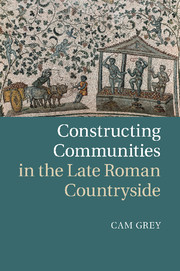Book contents
- Frontmatter
- Contents
- Preface
- List of abbreviations
- Map The late Roman world (sites and regions discussed in the text)
- Introduction
- Chapter 1 Constituting communities
- Chapter 2 What really matters
- Chapter 3 Small politics
- Chapter 4 Power as a competitive exercise
- Chapter 5 Resistance, negotiation, and indifference
- Chapter 6 Creating communities
- Chapter 7 Unintended consequences
- Conclusions
- Bibliography
- Index
Chapter 2 - What really matters
risk, reciprocity, and reputation
Published online by Cambridge University Press: 07 September 2011
- Frontmatter
- Contents
- Preface
- List of abbreviations
- Map The late Roman world (sites and regions discussed in the text)
- Introduction
- Chapter 1 Constituting communities
- Chapter 2 What really matters
- Chapter 3 Small politics
- Chapter 4 Power as a competitive exercise
- Chapter 5 Resistance, negotiation, and indifference
- Chapter 6 Creating communities
- Chapter 7 Unintended consequences
- Conclusions
- Bibliography
- Index
Summary
The peasant households of the late Roman world were flexible and dynamic entities, whose fortunes rose and fell according to their capacity to maintain an equilibrium between their resources and their needs. A change in the composition of the household – the birth of an infant, the marriage of a child, the death of an elderly member of the family – will have impacted upon both a household’s capacity to exploit its economic resources and its needs for sustenance. A bad harvest or a collection of adverse climatic fluctuations placed economic pressure upon the household, and might have tipped the fragile balance between subsistence survival and crisis. Equally, a series of good years, or a little good fortune, could have enhanced the household’s wealth and provided an opportunity to climb the social ladder, but may also have exposed the household to jealousy and gossip within the community of which it was a part.
Dearth and prosperity alike were potentially disruptive of a peasant household’s equilibrium and were likely in addition to place pressure upon the cohesion and character of the community more generally. Therefore, both may be categorized as a type of risk. Comparative literature suggests that peasant households and communities develop and maintain a sophisticated apparatus of strategies for mitigating and managing both phenomena, and we witness some, at least, of these strategies among peasants in the late Roman world. Peasants practiced complex crop and field rotation regimes, and farmed fields spread widely across the landscape, in order to minimize the chance of a single disaster wiping out their entire year’s produce. They periodically modified the composition of their households, removing dependents in response to productive downturn, and adding labor to supplement the household’s resources and utilize its economic assets in times of plenty.
- Type
- Chapter
- Information
- Constructing Communities in the Late Roman Countryside , pp. 58 - 90Publisher: Cambridge University PressPrint publication year: 2011

